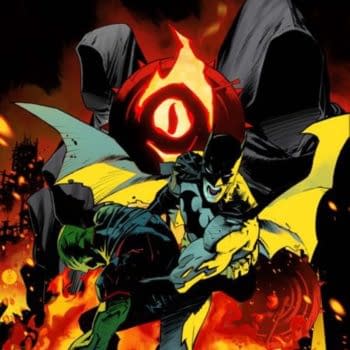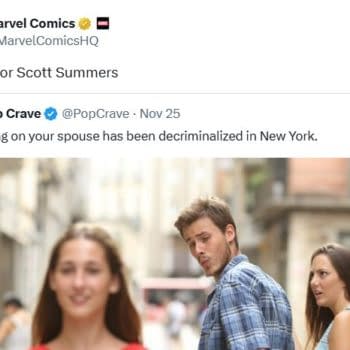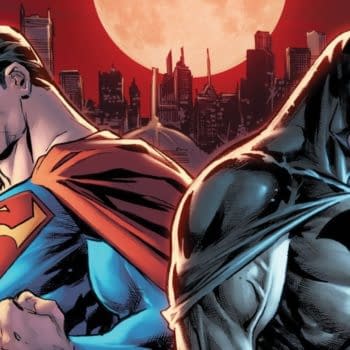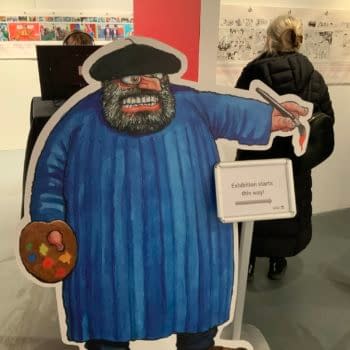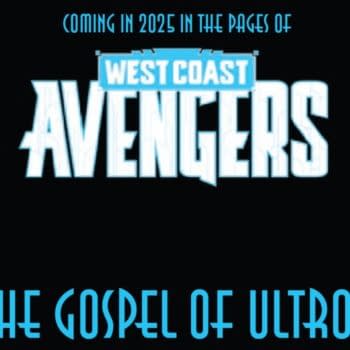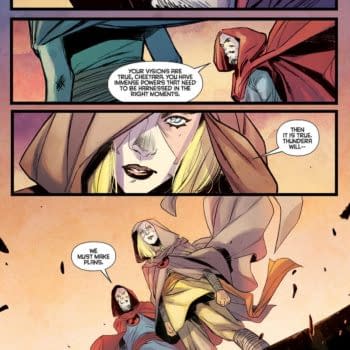Posted in: Comics | Tagged: comic, kickstarter, Nathan Sage, Ron Joseph, The Shepherd
Finding Astrid: The Making Of A Comic Book
Nathan Sage writes for Bleeding Cool:
I'm standing in the ruins of an old temple, somewhere in the middle of this world we've created out of pencil and paper. Everyone is frustrated with me–my wife, for being so absent from her, my dog Doolittle, for leaving his leash to rot, and my artist Ron, for sending him on yet another fruitless wild goose chase. The trouble is, neither of us can find Astrid.
Let's flip back to the beginning.
I squeeze down on my frayed stack of comic books and walk into a pub called Nadine's Irish Mist. The place is empty, except for one dude who's built like the Incredible Hulk, if Hulk were a bald truck driver with a manicured beard. And Hulk is looking at my comic books, so I know he's our guy.
Ron Joseph had made an impression on me with this spectacular two-page spread of Cthulhu that made you fear for your life. Now, sitting in this pub, we chat 80s comics and I mention G.I. Joe issue #21: The Silent Issue, and, right on cue, he rattles it off. It's an obscure comics issue from 1984 that has no words in it–pure visual storytelling. Nobody knows about The Silent Issue, except for those of us that do, and we have a secret handshake.
Aside from G.I. Joe, Ron and I have one other important thing in common–we're both in love with the story of The Shepherd. On this distant planet, a young tribal shepherd named Astrid is watching her flock one day when she comes upon a wounded beast of legend that should have been extinct a thousand years ago. As if her decision of whether to help the beast weren't enough, the hunters then show up after the beast, forcing Astrid to call upon every ounce of strength and goodness in her to come out of this alive. Ron draws frantic sketches for me on a napkin, and soon we've made an audience of the rest of the souls in that pub.
Creating the of the world of a comic book is grueling. One day you come up with three designs that are all home runs, and the next you're in the mire. So you wipe the slate–try something new–we do this with Astrid. But no matter what we try, she just doesn't look right.
Here's the way it works when we design a character: I send Ron a description, along with a bunch of pictures for reference–the kimono in this one, the sleeves off the dress of that Tibetan mountain woman, the Cambodian headdress in this other one. Ron adds his spin to it, integrating the things I suggest each time, and yet it doesn't *feel* like Astrid. I tell Ron "I'll know it when I see it." A freelancer myself, my boilerplate response to any client who tells me "I'll know it when I see it" is "go set yourself on fire and jump off a cliff." And yet, here I am, saying it to Ron.
With each new design, I realize things about the character of Astrid. I realize that I don't want her to feel too war-like–that she mustn't simply be another badass woman–because then everything about her would be obvious. She must also have moments of joy, of curiosity, of that kind of flying feeling you get when you roll down the window and stick your hand out. I learn this by looking at Ron's art.
I'm beginning to discover that the art and writing of a comic book cannot be separated; because, in a really great book, the art informs the writing and vice versa. Ron's art speaks to me, and I take it back to the notebook and allow it to change the way I write Astrid.
Astrid stands facing the monster, her back to me. It's a moment when her grit and courage must be balanced with goodness and compassion, and I'd like to see her face, but I can't. My wife snaps her finger–"I'm right here," she says, nursing a cup of coffee across the table from me.
My wife Stephanie is a rare bird–she gets lost in cook books and fluffy blankets, and once she falls in love with a song she plays it over and over again until the tedium melts a scowl into my face. We fell in love when I was nineteen, and one particular night she held me and said we should always stay together, so we ran off and got married that weekend–didn't tell anybody about it. She pushes my cup across the table and it spills a little, but I don't care. All I care about now is finding Astrid.
We're coming down to the wire now. We'd planned to have a cover done a week ago, but we're still lagging on our title character. By now the character design has gone through its veritable gauntlet of phases–a medieval phase, a Celtic priestess phase, even a strange Tron-inspired phase where we try electroluminescent clothing elements to bring her closer to the sci-fi side of her world. Jake Isenberg, our inker, emails to ask when those pencils are coming in. I stare at my screen, watching the cursor blink.
The geography of a comic book is different than it used to be. Nobody works in the same office anymore, not even me and Ron, who live just a half hour from each other in the Beach Cities of California. I have to get my act together on the writing and edits and concept approvals, so Ron can get the pencilling done on 11×17 sheets, run those to Kinko's to scan them at a high resolution and beam them across the country to Indiana, where Jake Isenberg prints them out in light blue ink, again on 11×17 sheets, before painting them in great detail with brushes dipped in India ink. From there the inks shoot down to Monterrey, Mexico where our colorist Zoar Huerta brings them to life with her digital brushes, before sending them right back up to California to me and Ron. And right now, we're bottle-necked at the very start of that process.
At a certain point, the designs for a character all start looking the same; the design itself gets tired. I begin swinging wildly, sending Ron a completely different set of reference images for several days in a row–haute couture pieces by Alexander McQueen on Monday, Chinese wedding gowns on Tuesday, Paul Poiret dress designs from the 1920s on Wednesday. Ron wants to knock my block off.
And the truth is, Astrid is the only thing missing in this world we've built; from rock formations to waterfalls to civilizations and their technologies to creatures great and small and the plants and prey they eat. Our sublime vision is missing nothing but its leading lady.
I send Ron a picture of a woman in a bright leather one-piece garment that you might see on the streets of New York during fashion week. He knows it won't work, but draws it for me anyway. And when it inevitably fails, I take him to task on his drawing. He tells me to screw myself and closes shop for the day. And for the first time in this project, I start to worry that I've destroyed everything.
Ron pulls me aside. Tells me he wouldn't have gone with me this far if he didn't believe in the story–if he didn't believe in our friendship–if he didn't believe in Astrid. Points to all those moments when it felt we were so close. What about those? How did we at once find ourselves so far away? I have an answer, but it's broken into a hundred thoughts and scattered throughout my mind in places I can't reach. A semi-truck goes by, hushing us for a moment. Ron cracks a smile.
"I'm buying her a ring," he tells me. This shift of topics comes out of nowhere. Throughout the project, he's spoken of this woman he's in love with, a Mary-Ann. He is transfixed by her. Has a kind of honesty with her, a deep respect for her strength and gentleness. You can see her soul through Ron's face; a light pours out when he talks about her.
Ron tries one more design. He pulls all the best elements from his previous attempts–the leatherwork around her waist from this one, the way the garment sweeps down around her neck from that one, the shoes from a third. And he adds a headpiece inspired by that of a tribal woman from the hills of Kazakhstan. Ron draws the piece passionately, making every part of it his own. And it is perfect.
I'm sitting in my reading chair–this old turquoise armchair from the 1960s that Stephanie picked up for 40 bucks on Craigslist, knowing I'd love it–and I'm holding up an 11×17 printout of the cover. Astrid is at its center, her shepherd's staff held with both hands, the monster looming large behind her. There is a certain meditative quality to her–she's not bothered by the monster, not provoked to fear or fury–she just *is.* I look closely at her hands, and I'm struck by how much they remind me of Stephanie's hands.
In the end, in order to find Astrid we'd had to build an entire world and fill it with ourselves. We'd had to search through the valley to find someone endowed with meaning for both of us. Astrid needed not just our minds; she needed the strings of our hearts.
Stephanie comes in and sits on the arm of my chair, and touches my hand. She doesn't say anything. She doesn't need to say anything.














